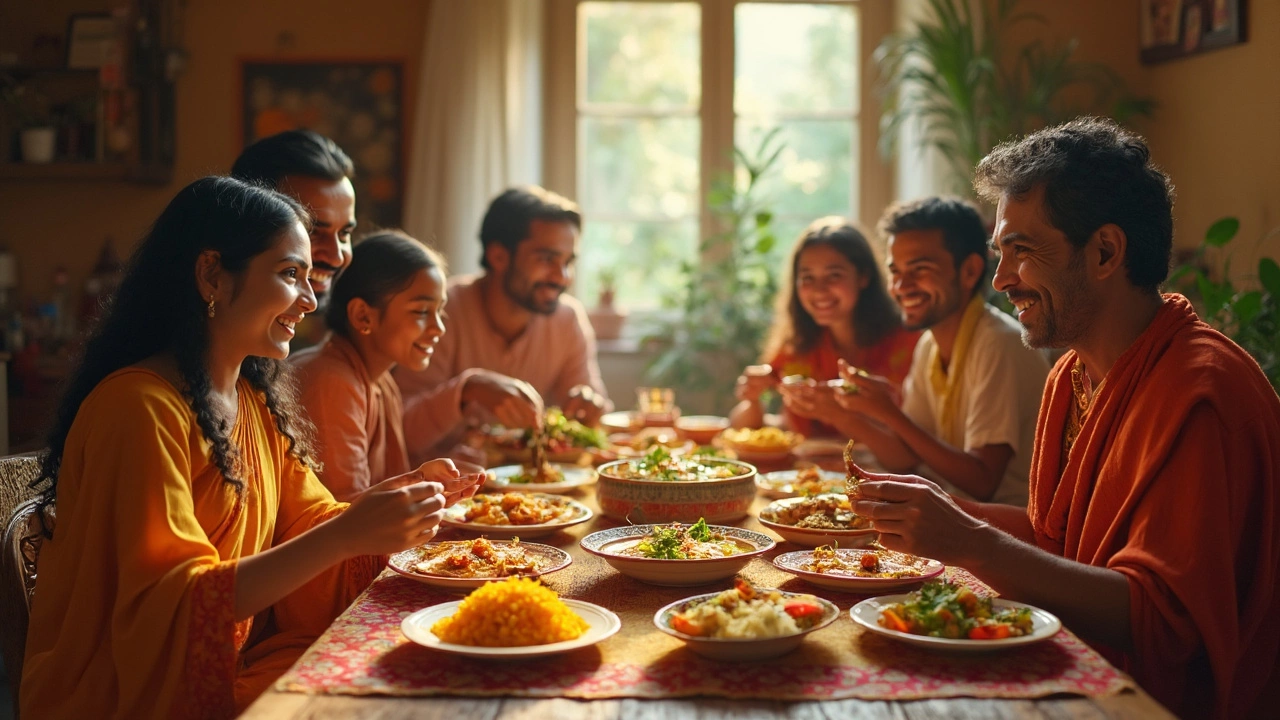6 May 2025
- 0 Comments
If the thought of fiery curries makes your eyes water, you’re not alone. Loads of people skip Indian food just because they think it’s all about the heat. That’s a big myth. In fact, you can eat really well in India—no sweating or gulping water between bites needed.
Some of the most comforting Indian meals are either naturally mild or can be requested without any chili at all. From creamy dals to buttery breads and gentle vegetable curries, there’s a lot to explore if you know what to look for. The real kicker: spices aren't just about heat. They bring out flavor, not just fire. So you won’t be missing out on taste just because you skip the chilies.
Whether you’re heading to a restaurant, grabbing a meal from a street vendor, or cooking at home, there are smart ways to avoid the burn and still soak up all those Indian flavors. You just need to know what to ask for, what’s safe to try, and a few easy tricks. Let’s get right into it!
- Why Most People Think All Indian Food Is Spicy
- Classic Indian Dishes Without the Heat
- Tips for Ordering Mild Food in India
- Easy Mild Indian Recipes to Try at Home
Why Most People Think All Indian Food Is Spicy
This idea that all Indian food will set your mouth on fire? It’s honestly everywhere, especially outside India. The thing is, that stereotype isn’t totally accurate. Let’s break down how it got started in the first place.
First off, Indian restaurants outside of India almost always dial up the spice. They do this on purpose because they think that’s what international diners expect. In reality, chili peppers only became a part of Indian cooking about 400 years ago, after being brought over from the Americas. Before that, food was flavored with herbs and mild spices like cumin, coriander, and turmeric.
India’s so huge, it’s got dozens of different cooking styles. If you only tried food from, say, the south or from street vendors in big cities, you might just get the spiciest stuff by default. In contrast, a lot of northern and central Indian dishes are pretty tame and focus more on dairy, nuts, or even fruit-based gravies.
| Region | Typical Spice Level | Main Ingredients |
|---|---|---|
| North India | Mild to Medium | Paneer, cream, wheat bread |
| South India | Medium to Hot | Rice, coconut, chilies |
| West India (e.g. Gujarat) | Mild | Lentils, yogurt, vegetables |
| East India | Mild to Medium | Fish, mustard, rice |
TV and movies aren’t helping matters either. You always see a character gasping or running for water after trying a curry. But go to a real Indian family’s home, and you’ll notice that spice levels are adjusted for each person. In fact, in a 2022 survey about Indian food preferences, 64% of urban Indians said they cook “mild to medium” at home, especially if they have kids or older family members.
Bottom line: only some Indian recipes are built to be hot. Once you know which dishes to look for, you’ll realize there’s a whole side of Indian food that’s gentle but still full of flavor. That busted myth is your ticket to eating well without all the heat.
Classic Indian Dishes Without the Heat
If your idea of Indian food equals chili overload, you’re missing out. Loads of everyday dishes are tasty, filling, and totally low on heat. Some regions, like Gujarat and Bengal, use more sweet or tangy flavors than fire. Others, like South India, offer coconut-based meals that are mellow by nature. Not all curries are set-your-mouth-on-fire types!
Here are some really popular non-spicy Indian dishes you can look for, whether you’re traveling or cooking at home:
- Dal Tadka (without chili): Lentils are simmered with turmeric, cumin, and garlic—skip the green chilies and you’re golden. Protein-packed and filling.
- Paneer Butter Masala: This is creamy, mild, and meant to be more sweet than hot. It’s one of those mild Indian meals you’ll find at almost every restaurant.
- Navratan Korma: A mixed-vegetable curry in a cashew and cream sauce. Naturally mild and super satisfying.
- Vegetable Pulao: Rice cooked with vegetables and gentle spices like bay leaf and cinnamon, but rarely chili.
- Malai Kofta: Soft cottage cheese dumplings in a creamy gravy. The sauce is all about nuts and milk, not heat.
- Dahi Bhalla: Soft lentil dumplings soaked in cool yogurt. More tang than spice here—plus a big hit at North Indian weddings!
- Stuffed Paratha: Flatbreads filled with seasoned potatoes, paneer or cauliflower. If you ask for them without chili, they’re hearty and mild.
"Not all Indian dishes are spicy; in fact, most households prepare meals tailored to personal heat preferences," says food historian Pushpesh Pant in his book on Indian home cooking.
Worried about ordering from a menu? Just remember these key words: korma, makhani (butter-based), and malai (cream-based) almost always mean mild.
Here's a quick peek at which types of dishes are usually mild by region:
| Region | Typical Mild Dishes |
|---|---|
| North | Paneer Butter Masala, Dal Makhani, Stuffed Paratha |
| West (Gujarat) | Dhokla, Thepla, mild Kadhi |
| East (Bengal) | Shukto, Chingri Malai Curry |
| South | Curd Rice, Coconut Stew |
If you’re grabbing street food, look for samosas or bread pakora. They might come with spicy chutneys, but you can always skip those.

Tips for Ordering Mild Food in India
Navigating a menu in India when you’re not into spicy food might feel tricky, but with a few phrases and some know-how, you won’t have to settle for just plain rice. Here’s what works if you’re looking for mild Indian meals—whether at a fancy spot or your neighborhood dhaba.
1. Be Clear and Direct
Don’t be shy about telling your server, “No chili, please” or “I don’t eat spicy food.” Many Indian kitchens, especially in bigger cities or tourist areas, are used to these requests. The local phrase for less spice is “kam mirch” (pronounced ‘kum murch’). Saying “Bilkul mirch mat daalna” means “Don’t add any chili at all.” These phrases can be a lifesaver.
2. Ask About the Dish
Some dishes are almost always spicy, like vindaloo or chettinad. But others, such as dal makhani, shahi paneer, or navratan korma, are usually cooked mild and rich. Always double check. Just because something looks creamy doesn’t mean there’s no heat! Asking questions is your best bet.
3. Order Sides and Dairy
Dairy-rich sides are your best friends. Curd (plain yogurt), raita, or a glass of sweet lassi will cool your tongue if you get a surprise kick of chili. Breads like naan, roti, and paratha are almost always mild and great for balancing out your meal.
4. Choose the Right Region
Not all of India loves chili. Food from Gujarat, Kashmir, and most of South India’s Kerala state tends to be milder. Rajasthani or Punjabi food can often be fiery, so stick to regions that use less chili for a more comfortable meal.
5. Spot the Spicy Traps
Buffets, street food, and thali meals can be unpredictable. Even a salad might have green chili hidden inside! Always sample a little before diving in. When in doubt, stick to simple non-spicy Indian dishes that you recognize, and always keep water or yogurt at hand just in case.
- Say "No Chili" or "Kam Mirch" clearly
- Check if the dish is naturally mild—like dal makhani, malai kofta, or jeera rice
- Add yogurt or order a lassi with your meal
- Choose wheat breads for safety
- If trying street food, start small and taste-test before you commit
Plenty of locals order food light on spice—some Indian families have kids or elderly folks who can’t handle heat. So don’t feel embarrassed. Just be clear about your needs. That way, you’ll enjoy those mild Indian meals and skip the tears.
Easy Mild Indian Recipes to Try at Home
Cooking non-spicy Indian dishes at home is completely doable, even if you don't have fancy skills or hard-to-find ingredients. Indian kitchens use loads of flavorful spices—like cumin, coriander, and turmeric—that bring depth to dishes without burning your tongue. Here are a few easy Indian recipes that are perfect for folks who want all the flavor, minus the heat.
- Khichdi: This is India’s answer to comfort food. Made with rice and lentils, khichdi gets its magic from mild spices and a little ghee (clarified butter). It’s super gentle on the stomach and a staple in many Indian homes. You can toss in some vegetables like carrots or peas if you want extra nutrition.
- Dal Tadka (No Chili): Dal—or lentil soup—can easily be made without chili powder or green chilies. Use cumin, turmeric, and a tiny bit of garlic for that signature Indian kick. Serve it with steamed rice and you’re golden. Fun fact: dal is so central in India that over 70% of households eat it almost daily.
- Paneer Butter Masala: Love creamy dishes? This one’s a winner. Paneer cubes (Indian cottage cheese) are cooked in a buttery, tomato-based sauce with barely-there heat. You can go chili-free and still get that delicious restaurant taste. Pair it with naan or plain paratha for a filling meal.
- Aloo Matar: This is a simple curry with potatoes and peas, cooked in a mild gravy. Just skip the chili powder and stick to turmeric, coriander, and garam masala (if you want, go easy on the masala, too).
- Cucumber Raita: Not technically a main dish, but seriously useful! Mix chopped cucumber with plain yogurt, cumin powder, and salt. It cools your belly and balances any spices in your food.
Here’s a quick comparison of the main spices used in these mild Indian meals versus the spicier versions:
| Dish | Main Spices (Mild) | Typical Spicy Version |
|---|---|---|
| Khichdi | Cumin, turmeric, ginger | Chili powder, green chili |
| Dal Tadka | Cumin, turmeric, garlic | Red chili powder, green chili |
| Paneer Butter Masala | Coriander, garam masala (optional) | Chili powder, extra garam masala |
Some quick tips: Always taste as you go, since Indian spices can taste strong even without chilies. Swap out fresh chilies with herbs like cilantro if you want a pop of color or extra freshness. And if you’re unsure, double-check online recipes—most have a ton of comments from people who also want less spice, so there’s always advice to tweak your easy Indian recipes for your own comfort level.
